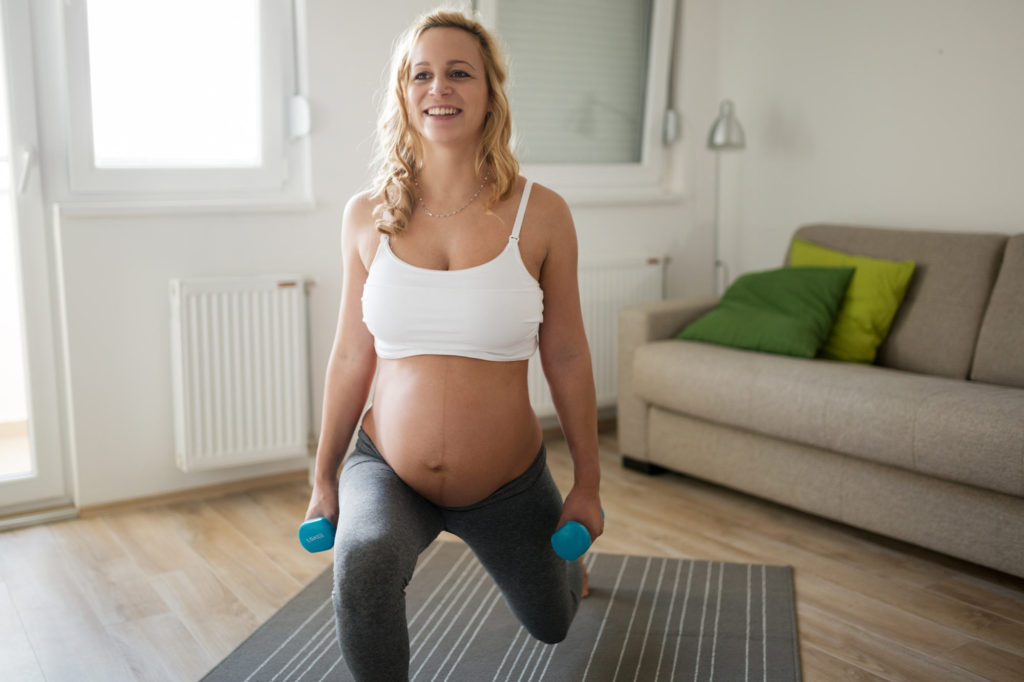
Pregnancy doesn’t mean you have to stop exercising or lifting weights, despite what people may tell you. However, there’s no clear-cut answer for everyone.
It’s an old adage that pregnant women shouldn’t lift, well, anything really. You might have heard this from your mother, friends, or even online “experts” giving specific weight restrictions: “Don’t lift more than 15 pounds,” or “Don’t lift anything above your head!”
But is any of it true?
Well, yes and no, and for different reasons.
First, the research.

One misconception that you’ll find everywhere is that lifting heavy objects, or even any exercise at all, can cause miscarriage or preterm births. This is a sweeping generalization that the research doesn’t back up. However, you see this information floating around for good and responsible reasons.
CDC and other official recommendations are for female workers—not female fitness enthusiasts.
If you do a Google search for “pregnancy and lifting weights” or something similar, you’ll probably find the CDC recommendations come up first. The CDC states that “Heavy lifting, standing for long periods of time, or bending a lot during pregnancy could increase your chances of miscarriage, preterm birth, or injury during pregnancy.”
However, the page this is listed on is entitled “Reproductive Health and the Workplace.” Workplace. And the recommendations are derived from studies of women who have physically demanding occupations. They aren’t sitting at a desk for eight hours before a 30-minute weight training session at the gym. They lift, bend and stand for many hours of the day, repetitively.
Repetitive movements that seem innocuous can actually cause a lot of problems (hello, carpal tunnel syndrome). Because you’re not overloading the system when it’s spread out over a full day, it might not seem strenuous. However, it’s my guess that complications and injuries can arise once general fatigue sets in over the course of the day and form might get lazy. Plus, it’s easy to lose sight of form when you’re lifting heavy objects for reasons other than form and strength training.
On top of all this, pregnancy releases a hormone called relaxin (I know, it sounds made-up) that makes your joints a lot more flexible and prone to injury. Oh yeah, and it’s work. It’s stressful.
My point is that women working strenuous jobs have a much different physical and mental profile than those who don’t, and you can’t compare “lifting all day at work” to “lifting weights in a gym,” pregnancy or not.
In fact, studies have shown that exercise might decrease all those scary pregnancy complications (preterm birth, gestational age, and caesarian section). However, where that “exercise” includes strength training, I was not able to find out.
Don’t be mad at the CDC.
Furthermore, it’s a really good thing that these studies exist to protect pregnant women in the workplace. It’s also good that they air on the conservative side. No pregnant woman should feel obligated to put herself and her baby at potential risk.
However, it doesn’t mean you can’t lift weights, even heavy weights, at the gym (or home gym). And if you do have a physically demanding job, I am guessing and hoping that your employer has scaled back any demands so you can be comfortable throughout the day. Again, know your body and what you can do.
Listen to your doctor.

Every person is different, and every pregnancy is different. There is no one-answer-fits-all for whether or not it’s okay for you to lift weights while pregnant.
Most importantly: listen to your doctor. If your doctor tells you to take it easy, take it easy. If they say you need bed rest, then no, you shouldn’t be moving around much, let alone starting a weight lifting routine unless it’s recommended by your doctor.
Nothing is more important than the health of you and your baby during pregnancy. If rest is what you need, then take this time to explore other avenues and interests, and you can resume exercise and lifting weights when your doctor gives you the go-ahead after your pregnancy is over.
Listen to your body.
As long as your doctor is fine with activity, then it’s time for you to tune into your body and what it wants and feels comfortable with.
Pre-pregnancy should dictate what you can do during pregnancy when it comes to lifting weights.

While studies seem to be misleading or nonexistent, the general expert advice (that is also rational and informed) is that if you could lift heavy weights before, you can lift weights during pregnancy. Simple as that.
If you have never lifted weights before, then pregnancy might not be the right time to start. Again, ask your doctor. Bodyweight exercises and workouts are normally great for beginners, but also include a lot of agility, core and plyometric moves, which aren’t ideal for pregnancy, especially as you enter the second and third trimesters.
If you lifted weights before pregnancy, then you should have a good idea of what your body is capable of. You can also be a bit lenient with what your doctors say here, as long as you and baby are healthy. Online searches, and even doctors, might give you an arbitrary number of pounds, but the truth is, there is no magic number that is dangerous to go above.
And people (even doctors) underestimate what women can and do lift. If you have 40-pound children that you’re constantly carrying around, or you were an avid lifter before, lifting 40, 50, 70, 100 pounds at a time, it’s ridiculous to think you have the same weight limit as someone who doesn’t lift weights at all.
The truth is, as long as it’s not a huge strain for you, lifting more than the “recommended amount” you read or hear about is perfectly fine.
Flatten the curve.
Now, you won’t be hitting new fitness goals while pregnant, so don’t try. You probably won’t be maintaining your level of fitness, either, unless you weren’t terribly active. This will be a time to take a few steps back while your body takes on more important tasks. It will also make it easier to get back to your pre-pregnancy fitness levels after the baby is born, not to mention keeping your physical and mental health at good levels.
In other words, make that curve downwards flatter rather than steeper. Remember “flatten the curve” when COVID first hit? Yeah, we didn’t really do that, but you get the idea.
The perceived rate of exertion does need to be less, though.

You do need to lessen the intensity, though. Part of this will be easy, because excess weight, fatigue and extra blood in your body will mean you can’t keep up with your old fitness levels anyway. Everything is harder. And I mean everything. Even walking down the street or going up a flight of stairs. For me, getting out of bed is even a hassle.
The other part is to recognize when you’re hitting your limits and modify accordingly.
If we take exertion levels on a scale from one to ten, you want to keep your overall level while pregnant to a six or seven. If you hit an eight a little bit, and on an exercise you feel comfortable with, you should be fine. Just don’t maintain the eight. Bring it back down.
This is all subjective, but I’d say normal pre-pregnancy rates of exertion for a regular exerciser would be:
- Casual walk: 3
- Hike: 5 to 7 (depending on uphill scale, fitness and terrain)
- Jog: 6 to 7
- Run: 7 to 9
- Sprint: 10
- HIIT: 8 to 10
- Weight lifting: 7 to 10 (10 on that last rep if you go to fatigue)
Normally, when we hit a level eight or higher, we try to push through. When pregnant—yeah, don’t do that. Stop, take a break or modify down the exercise.
Modify.
You might need to lessen the weight a bit, which is a simple modification if you have various weights available. Some doctors suggest lessening the load by about 20 to 25%, which seems reasonable. If you don’t have lighter weights, lessen the reps, rounds or time of the interval or overall workout.
Other modifications could include varying the weight equipment (kettlebells to dumbbells), adjusting hold or stance, adjusting angle (doing push-ups with your hands on a chair or against the wall instead of on the floor), lessening the range of motion (not going down as far on squats), slowing down the exercise (placing feet out in a burpee instead of jumping them out) or simplifying the exercise.
Also, stay away from any exercise that has the ability to hurt you or your belly.
Stand your ground.
Stability is also important. This isn’t the time to break out the Bosu ball and do squats on it. And remember that relaxin I mentioned earlier? It’s for real, folks. Just the other day I was walking down the street, turned my head while still walking and said, “Hey! Look at that!” and took a giant spill. My ankle just rolled under me (in knee-high boots, mind you) and I skinned my knee. (Baby’s fine, so no worries there.)
So yeah, it sucks, but make sure you have firm footing and holding on everything because it’s a lot easier to injure yourself.
What about HIIT?
HIIT, or High Intensity Interval Training, is an amazing tool that’s not only trendy, it’s effective and efficient.
Is it okay for pregnancy? Well, technically, no, since true HIIT means you’re going all out each and every interval. You’re ideally hitting a seven to a ten on the exertion scale.
However, you can still include HIIT if you don’t overdo it (keep it to once or twice a week, max) and you take out the “high intensity” part and change it to a more “moderate intensity.” Also, make sure that any HIIT section is no more than 15 or 20 minutes, and if it is, then take breaks, maybe at each round’s end. Increasing the rest time is another way to make HIIT more manageable during pregnancy.
I should mention that HIIT isn’t a form of weight lifting, nor is it ideal for it. The exertion usually comes in a more metabolic (read: out of breath) form rather than muscle fatigue. While it’s not ideal for building muscle alone, it’s a great way to build some muscle while also losing fat and giving your heart a good workout.
However, you see HIIT being used in all different ways, including hybrids of cardiovascular and strength training exercises. One of my favorites, Hannah Eden, mixes both very well, as does Tatianna and Zuzka. These types of workouts, HIIT or not, are called Metabolic Resistance Training, and it’s the bulk of the workouts I typically do (when not pregnant).
Try AMRAPS instead.
If you like the time limit on HIIT but don’t want the intensity, try modifying to an AMRAP (As Many Rounds As Possible). Instead of doing 20 intervals of 15 seconds rest and 45 seconds work, you’ll set the timer for 20 minutes and run through the exercises until the timer is up, taking breaks whenever you need them. It’s a nice way to naturally lower the intensity but still keep the crisp time limit. You will have to set a certain amount of reps for each exercise, though. Check out more workout formats here.
Conclusion.
Lifting weights is perfectly safe and normal for a normal pregnancy. Not only that, but yes, you can lift “heavier” weights as long as you could lift heavier weights before, you’re stable and safe, you can breathe properly through the exercise, and your rate of exertion hovers at healthy levels.
